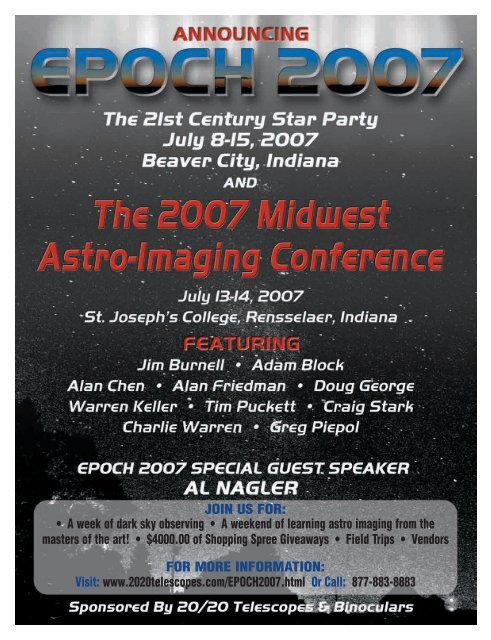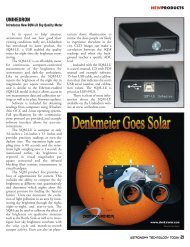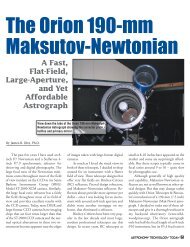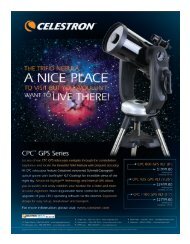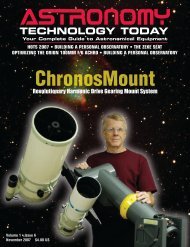April Cover24-27 - Astronomy Technology Today
April Cover24-27 - Astronomy Technology Today
April Cover24-27 - Astronomy Technology Today
You also want an ePaper? Increase the reach of your titles
YUMPU automatically turns print PDFs into web optimized ePapers that Google loves.
JOIN US FOR:• A week of dark sky observing • A weekend of learning astro imaging from themasters of the art! • $4000.00 of Shopping Spree Giveaways • Field Trips • VendorsFOR MORE INFORMATION:Visit: www.2020telescopes.com/EPOCH2007.html Or Call: 877-883-8883
OPT AND PENTAXA Match MadeFor The HeavensBy Eric BlackhurstIt has beena little over 20years since PentaxUSA ceasedimportingPentax Refractorsin the mid-1980s.This story began again in 2003, when a Japanese gentleman brought one of the Pentax 100SDUF Refractors into OPT, trading it toward other equipment. Just getting into DSLRastrophotography, I felt that it would be foolish to pass up the opportunity to try imaging withthe well corrected f/4 refractive system. After the very first night, I was in love and convincedthat these fine instruments needed to be brought back into the U.S. It took a little over twoyears of negotiating with various members of Pentax USA before OPT secured the ability todeliver these instruments to U.S. customers.Pentax Refractors are designed around application to both visual observation and imaging.With exceptional color correction and magnificently flat fields of focus, they offer the ability tocapture breathtaking views and photographs. The ingredients that make this possible are thehigh-quality SD glass, well-designed baffles, and integrated field flatteners. Top-rate multi-coatings,in addition to the optical purity of the glass used, lead to transmission of 90%-plus of lightbetween 400 nm and 800 nm through the systems (not just through a single element). As aresult, these three and four element designs still offer tremendous contrast, rivaling traditionaldoublets and triplets, while offering flatter focal planes.In recent years, the landscape of the hobby seems to have taken a dramatic shift towardCCD and DSLR imaging, in addition to visual observation. The number of amateurs whodevote all of their energies to imaging has grown a little, but the number whose activities includecasual astrophotography, as well as viewing, has exploded. While many manufacturers have goneabout designing and redesigning optical systems to suit both functions, Pentax was alreadythere.The SDHF, SDUFII, and SDP series refractors were not only made to work well forphotography, they were designed around medium-format film photography. Consequently, theyboast very large, well corrected circles of illumination, from 70 mm with the 75SDHF up to88 mm with the 100SDUFII and SDP series. It will be a little while before we are looking atCCD sensors exceeding those sizes, and it will be years before such sensors become affordable.<strong>Astronomy</strong> TECHNOLOGY TODAY 25
Pentax 75SDHFThe Pentax 75-mm SDHF makes an excellent all-around graband-go/travel-scopeor wide field, piggy-backed imaging system.With a 500-mm (f/6.7) focal length, it is very effective for wide fieldvisual observing and wide field photography. At the same time, itssuperior color correction and contrast provides pleasing views of theplanets, moon, and double stars at high magnification. With tubelengthof 18.5 inches, and a weight of 4.8 pounds, it is more thanportable. Finally, its three-element, two-group design features a corrective/flatteningelement at the rear of the optical tube, allowingPentax 100SDUFIIGiven that I spend the great majority of my time imaging, thisis my favorite member of the series, by far. The 400-mm focallength, f/4 design makes for exceptionally deep detail in even modestexposure times. The 100SDUFII is the smallest of the PentaxRefractors to incorporate the four-element, two-group optics. As aresult, it features an 88-mm circle of illumination, allowing you touse formats up to 6x7 cm without vignetting. While focus does gettouchy, due to the exceptionally fast focal ratio and short focallength, this refractor can still be used visually. I would not recommendthis optical tube to someone wanting a planetary instrument,but it is a wonderful wide-field visual telescope. The contrast isamazing, and it is a lot of fun to peek through a 4-inch refractor atmagnifications as low as 10x.Although the 400-mm focal length may sound short, it is actuallya very good fit in terms of arc-second/pixel resolution for many105SDP and 125SDPThe SDP series is the best suited for mixed-use. Both the105 mm and 125 mm incorporate the four-element, two-groupdesign, and offer 88-mm circles of illumination. However, they usea much more traditional focal ratio than the 100SDUFII, beingf/6.4 systems. This allows for them to be used for everything fromwide field to planetary when viewed through, with far less touchyfocus than the faster f/4 refractor. Having pushed them hard, in bothdaylight (artificial-star tests) and starlight, I have yet to notice falsecolor.I look forward to each and every time I have the opportunityto demonstrate one of these refractors at the many star parties OPTattends.With the slower focal ratio of the SDP series, color and focalplane curvature corrections are even more effective than in the SDU-FII, and that is saying a lot! The net result is a series of refractors thatare among the flattest and most well color corrected of any on themarket. When using eyepieces that are well corrected spherically,you can literally focus on brighter stars at the edge of the field invery sharp and well corrected images out to the edge of its 70 mmcircle of illumination.Mechanically, the 75SDHF is a little tank. The rack-and-pinionfocuser it features is robust enough to handle even large CCD cameras,making DSLR cameras a more than comfortable payload. Thefocus lock employed is an external compression ring, meaning thattightening and loosening the focus lock will lead to minimal movementof the camera or eyepiece position. To make this travel-scopeeven easier to stow, Pentax also made the dew shield collapsible.cameras, particularly DSLRs. With the 6.4 micron pixels of my EOS20Da, the resulting resolution is 3.28 arc-seconds per pixel. Whilethat is a little on the high side, it allows me to rarely need to worryabout seeing conditions for an imaging session. As long as it is clear,I can be out there. If you own, or are considering, one of the 10-megapixel, APS-size, DSLR cameras (such as the EOS Rebel XTi,D80, or D200) you will be down to a comfortable 2.7 arc-secondsper pixel, which is an even more ideal fit.The helical focuser used on the 100SDUFII allows for incredibleprecision in manual focusing, and is so robust it barely seems tonotice the weight of the imaging system I usually place on the backend:an SBIG ST-2000XM, SBIG CFW10 color filter wheel, andFLI DF-2 focuser. When the focus-lock, which internally increasesfriction on the helical, is left unlocked, I see no movement, evenwith 10 plus pounds of imaging equipment and cabling.order to nail critical focus for a faint DSO at center.While not quite as fast as the 100SDUFII, the 105SDP and125SDP are still remarkable instruments for photography. Here, thecolor-correction and field-flattening benefits of their design shineeven more than in visual use. The SDP series refractors produceamazingly round stars out to the edge of their 88-mm image-circle,outdoing some of their most highly regarded competitors when itcomes to the size and shape of star images.Mechanically, there is one noticeable difference between the105SDP and 125SDP: the focusers. While the 105 mm uses a rackand-pinion,essentially an oversized version of the one used on the75SDHF, the 125 mm uses a 4-inch helical, just like the 100SDU-FII, but longer in travel. Both focusers are quite robust, although thehelical of the 125SDP allows for more precise movements which areaccurately registered with its easily legible vernier scale. Either OTAis more than capable of taking the heaviest photographic equipmentused by amateurs today.Specs 75 SDHF 100 SDUFII 105 SDP 125 SDPLens Design 3 Elements 4 elements, 2 Groups 4 elements, 2 Groups 4 elements, 2 GroupsCoatings SMC Multi-Coatings SMC Multi-Coatings SMC Multi-Coatings SMC Multi-CoatingsAperture 75 mm (3") 100 mm (3.9") 105 mm (4.1") 125 mm (5")Focal Length 500 mm 400 mm 670 mm 800 mmf/Ratio 6.7 4 6.4 6.4Image Circle 70 mm 88 mm 88 mm 88 mmDrawtube Inside Diameter 59 mm 83 mm 90 mm 90 mmResolution 1.55 seconds 1.16 seconds 1.11 seconds 0.93 secondsVisual Limiting Magnitude 11.1 11.7 11.8 12.2Light-Gathering Power 114x 204x 225x 318xTube Diameter 2.95"/75 mm 4.53"/115 mm 4.52"/115 mm 5.5"/140 mmTube Length 18.5"/470 mm 19.37"/492 mm 29.4"/747 mm 36.3"/922 mmTube Weight 4.8 lb/2.2 kg 8.8 lb/4 kg 13.23 lb/6 kg 22 lb/10 kg
OPT AND PENTAXAdapters for US AstronomersAll of the Pentax Refractors distributed in the U.S.include an adapter chain that will go from the focuserdown to a 1.25-inch interface. This system reachesfocus only when 1.25-inch eyepieces are used in astraight through orientation. Knowing that most amateursprefer to be able to use a diagonal, we quickly realizedthat adapters would need to be fabricated for thispurpose, since they were not available from PentaxJapan. Consequently, OPT developed three adapters forphoto and visual use of the Pentax Refractors.Two of the adapters act as sleeves, stepping downfrom the 60.2-mm female interface, found in the standardfocuser adapters, to either a 1.25-inch or 2-inchfemale interface. This allows your current 1.25-inch or2-inch nose pieces, whether from camera adapters ordiagonals, to be used with the Pentax Telescopes. Thesetwo parts are the only way of using the Pentax 75SDHFwith diagonals; no other non-custom parts will allowfor infinity-focus to be reached. These adapters can alsobe used with the SDP series, and the 60.2-mm(1.25-inch) adapter is compatible with the 100SDUFII.The third adapter is a 2-inch photo/visual backdesigned to thread into the 84-mm thread used in thestandard adapter chain of the 100SDUFII, 105SDP,and 125SDP. This part is the only means of reachinginfinity focus with the 100SDUFII when using a 2-inchdiagonal and a 2-inch eyepiece. However, it is also themost practical and secure way of attaching any heavy2-inch nosepiece accessory to the SDP series.The Pentax line is available in North Americaexclusively through OPT at www.optcorp.com.All images wereshot by Eric withthe 100SDUFII.The top imagewas taken with aST-2000MX withAstonomik 13 nmH-alphafilter, and was3x20 minutes.The other twoimages are 3x10with a CannonEOS 20Da.TOP Rosette NebulaCENTER Trifid andLagoon NebulaRegionLEFT Pentax100SDUFIIBOTTOM LEFTSagittarius StarCloud<strong>Astronomy</strong> TECHNOLOGY TODAY <strong>27</strong>


